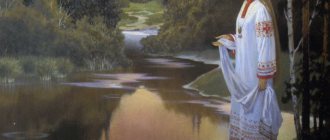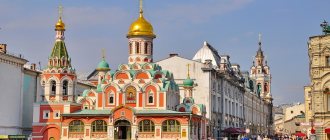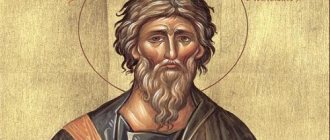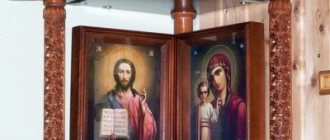A little from the history of writing early Christian icons
Since ancient times, visual culture such as encaustic painting has reached Christianity. It is she who is considered the ancestor and was based on painting with mixed colors. Many early Christian icons were painted using the wax tempera technique, one of the varieties of encaustic painting, distinguished by the richness and special brightness of the painting applied. This painting originated in Ancient Greece and then gradually came to Christianity. One of the earliest and most important icons in this style is the icon of Christ Pantocrator, the oldest and most famous image of Christ.
Why did the Lord give it to us?
Every gift from the Lord serves people for something important. Why does a Christian need an icon? What is the spiritual benefit of it? - Invaluable! There is a lot to be said about this.
During the Soviet persecution of the Church, icons were preached. This is literally what knowledgeable people said. And they were not mistaken. How it was?
At that time, the authorities tried to destroy church sermons outside the church and even extinguish sermons from the pulpit. So, in addition to preaching with the spoken word, the sermon reached people in a visible way - with an icon. And the sermon spread throughout the churches and far beyond the church fence. Icons were preached in museums. They preached in art albums on ancient Russian art.
The preaching of icons reached people who were very far from the idea of coming to church services.
The legend of the appearance of the first icon
So, according to icon painting experts, the very first icon is the face of Jesus Christ. This also happened during the Via Crucis, on the road to Golgotha, when the women wiped his face with a towel and the imprint of his face was left on the white towel. This medieval legend still goes by the name "Veronica's Plate", which takes its name from the woman who veiled her. Perhaps she was alone or there were several, but in her name the first icon only mentions the name Veronica.
The second version of the “birth” of the first icon, extended to the entire church, is associated with the Eastern tradition. The story of the creation of the icon tells of the artist, the king of Edessa, who was sent to depict Jesus, but the attempt was unsuccessful. Then Jesus Christ washed his face and wiped his face with a handkerchief, on which the imprint of his face actually remained. His beard was printed in a single strand resembling a wedge shape, which is why the badge became known as the "Savior of the Wet Beard".
Thus, if we talk about two church traditions, then during the years of the Savior’s earthly life the first icon appeared, which became a miraculous icon with the name of the Savior.
Where to look for its origins?
For a Christian, the main icon is the icon of Christ.
When and how did the first icon of the Lord Jesus appear? Of course she was. We have a special holiday in her honor in our Church. According to the calendar, the holiday falls on the day after the Dormition of the Blessed Virgin Mary. August 29 is a holiday in honor of the Image Not Made by Hands of the Lord Jesus Christ. The first icon of Christ was not painted, nor was it created by human hands. It was not a figment of the imagination of an ancient artist.
The first icon was given to us directly from the Lord. According to church tradition, the first icon was an imprint of the face of Jesus Christ miraculously appearing on canvas.
Giving people an icon was God’s will, not a human wish.
We Orthodox Christians should know this well.
The icon is a gift from God.
The first master of icon painting
According to legend, the first man-made icon is the icon of the Mother of God, and the one who painted it was a Christian saint, one of the seventy disciples of Jesus Christ, the Evangelist Luke. In addition to painting the icon of the Most Holy Theotokos, he is credited with the icon of the two holy apostles: Paul and Peter, and about seventy other icons depicting the Virgin Mary. Only three of them were written by the Mother of God herself and received their blessing during her lifetime.
Such icons include: Smolensk, Korsun or Ephesus and Philermos Mother of God. According to legend, the evangelist Luke first imprinted on the table the image of the Madonna with a child in her arms, then painted two more, similar to the first, and brought her to the Most Holy Theotokos. All three are significantly different from the other icons of the Mother of God, which can give an extraordinary and unique idea of what she looked like Our Lady in earthly life.
There is even an icon that recreates the very process of painting the icon of the Most Holy Theotokos Luke.
After all, no one can give a specific answer to the question of when the first icons appeared. All this is so covered by the veil of the past that the further we move away from ancient times, the less opportunity becomes to know the truth. However, not everything remains unexplored. Thus, the first icons in the history of Christianity are considered to be: “Veronica’s Payment” and “Savior’s Wet Brad”, which became two options for the appearance of the first icon of the image of the Savior not by hand. And the first icon painter is considered to be the Evangelist Luke, who made a great contribution not only as the author of one of the four Gospels, but also as an artist who depicted the Blessed Virgin Mary on his canvas.
Icon in a political detective story
I remember a popular feature film from the mid-eighties. Political detective "TASS is authorized to declare" based on the script by Yulian Semyonov.
As expected, the plot is sharp: a coup is taking place in an African country, behind which are the American intelligence services. The CIA managed to recruit some high-level Soviet specialist. State security officers are trying to identify him and neutralize him. The topic, frankly speaking, is aside from religious life.
And yet, in one episode of the detective story there was a dialogue about an icon.
I'll retell it. A KGB officer comes to his ward, a seasoned artist, and gives him a letter written on behalf of a witness to the recruitment. The anonymous letter was planted at our embassy by someone who personally saw how the Americans treated the Russian specialist. The artist was asked the question: “Who do you think is the author of the letter? And how sincere is the author?”
The artist confirms the authenticity and sincerity of the letter. He believes that its author is a former Vlasov member. The intelligence officer seems to agree with the artist. However, he wonders why the interlocutor decided that the letter was real.
The old artist, who was once close to Vlasov circles, recalls a short story in response. He had a friend who restored icons. This colleague once showed his work; he copied a Russian icon of the 16th century. The copy turned out to be successful. And there was a small argument:
– Listen, why don’t you take up icon painting?
The restorer just laughed:
- What you! I'll never be able to do that.
– You, a talented artist with such an excellent school, will do worse work than this illiterate god?!
Then the restorer put the original next to it and said:
– Don’t you see the difference? This artist painted the icon with faith in God. But faith is difficult to fake. It's not even possible.
The 16th century icon was genuine. And the recruitment letter was hard-won, it was genuine...
I am still surprised: in a political detective story, the icon testified to genuine human religious feelings. Perhaps the icon was preaching here, from the Soviet television screen, about the religious experience that lies behind church art.
Yes, you can master the technique of icon painting, you can learn to copy ancient samples. But faith in the One Whom you write cannot be copied, it cannot be faked. To paint a genuine icon, you need the gift of God, the gift of faith, the gift of communication with the Lord.
Where did icons come from in Christianity?
The Holy Scriptures do not contain direct references to the obligatory veneration of icons for Christians. However, Church Tradition gives us several stories related to the veneration of images. The first of them is the legend about the Image Not Made by Hands, the face of the Lord Jesus Christ miraculously imprinted on a towel, which was given to the ruler Abgar in the city of Edessa for healing. The second is the legend according to which the Apostle Luke painted the first icon of the Mother of God, which was blessed by the Most Pure One herself. In the first centuries of Christianity, images were not widespread, but not for any doctrinal reasons, but for practical ones. Christians were often persecuted, and therefore were often forced to change places of worship. Even private houses in which community meetings were held were tried not to be marked out in a special way, so as not to incur persecution.
The exception to this state of affairs was the Roman catacombs, where Christians often gathered and could feel safe. It is here that we see the first examples of Christian painting: the frescoes “The Good Shepherd”, “Christ: Alpha and Omega” and others. Christians wanted to express their faith and prayerful state not only through prayers and chants, but also in art. This became the impetus for the development of the first iconographic images, which were distinguished by their naturalism, bright colors and symbolic plots.
This style of icon painting prevailed after the establishment of Christianity as the state religion in the Roman Empire, and during the period of the first Ecumenical Councils. Icon painters of that time used the ancient technique of encaustic painting and tried to find a special style of writing that would allow them to convey to the viewer the theological meaning of Christianity. Already at that time, the first features of the iconographic canon began to take shape. In 590, the Council of Trullo prohibited the depiction of Christ symbolically (as a lamb or otherwise), but only as the God-man. Unfortunately, few icons from this period have survived to this day, since most of them were destroyed during the iconoclastic persecution in the empire.
The movement against icons stopped the development of icon painting for more than a century. However, the restoration of icon veneration by the Seventh Ecumenical Council in 787 and the theology of the icon resulting from years of controversy were useful factors for a new stage in icon painting. From now on, the icon is not just an image to which believers render respectful worship. The icon now also carries a doctrinal meaning, reflecting the dogmas of the Church for the common people. This mission also changes the style of icon painting: it becomes more frozen, two-dimensional and very symbolic. A special icon-painting canon or rules are being developed on how to paint icons correctly. The lands of the Byzantine Empire and Southern Italy became the centers of icon painting. And if the Italian school was subsequently supplanted by religious painting of the Renaissance, then in Byzantium icon painting developed within the framework of the canons of the genre, although receiving some influence from society.
In Rus', the first Slavic icon painters began to appear already in the 12th century. These are famous master monks - Saints Alypius and Gregory of Pechersk. Gradually, by the 13th century, almost every big city had its own school of icon painting. Old Russian isographers followed the canons and at the same time added local flavor to the images. This is manifested in Russian icons in the facial features of Christ or the Mother of God, and the general style of image design. Further, icon painting in the Ukrainian lands continued to develop in its own original way. An example of this is the icons of the 13th – 14th centuries preserved in the churches of Western Ukraine, as well as later icons from the Cossack times, which absorbed many elements of the Cossack or Ukrainian Baroque.
In the 21st century, icon painting does not stand still, like any other art. Modern icon painters are trying to rethink the canons of the genre, presenting them in a new light that is close to modern people. After all, the desire to express our faith in colors remains with us. It will always be relevant for Christians of the new millennium, just as it was during the first centuries of Christianity.
Iconography begins with experience
What kind of experience is this? The experience of a real encounter with the real Christ. And the experience of prayerful communication with Him. Without this, there would be no true icon on Earth.
The Lord allows us to see His Face and turn to Him. Let us thank Him for this happiness.
Pravmir Dictionary - Icon
About several thousand, and some scientists even claim that millions of years ago man learned to speak, then people learned to draw, and only after that - to write. As for icon painting, it is as difficult to name the exact date of the appearance of the first icons as it is to say about the time of the appearance of speech and writing. However, there are many legends about how the first icons appeared.








